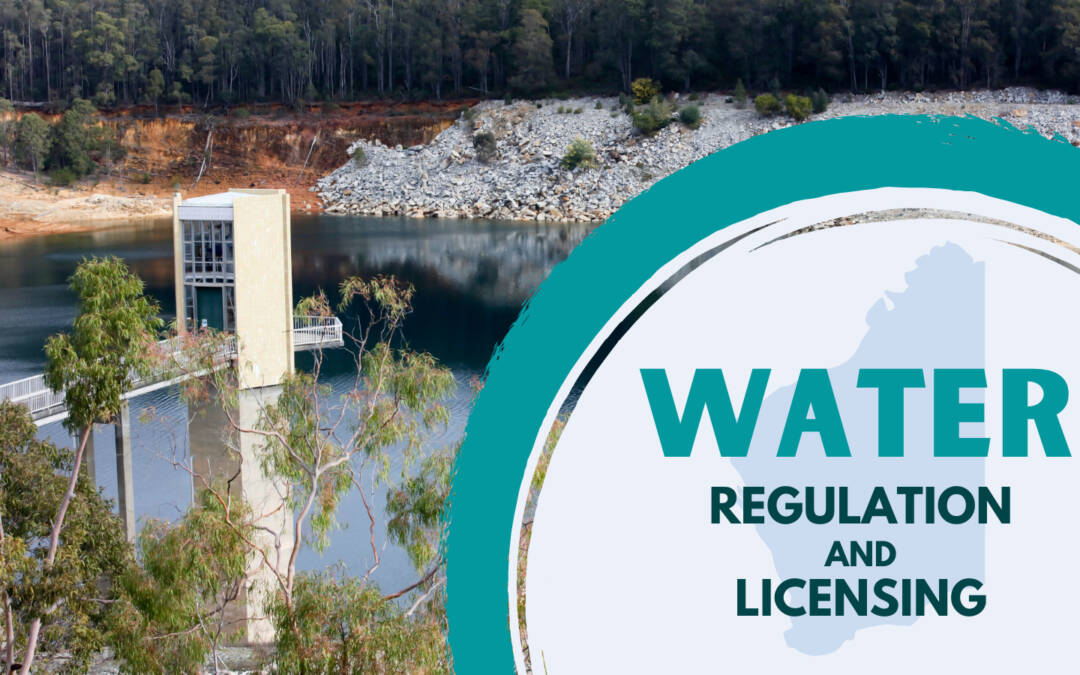The Department of Water and Environmental Regulation (DWER) is the water resource management agency for the state of Western Australia. Water resources are currently managed under six separate acts (DWER, 2017c):
- Water Agencies (Powers) Act 1984;
- Rights in Water and Irrigation Act 1914 (RIWI Act);
- Country Areas Water Supply Act 1947 (CAWS Act);
- Metropolitan Water Supply, Sewerage and Drainage Act 1909;
- Waterways Conservation Act 1976; and
- Metropolitan Arterial Drainage Act 1982.

Current Water Resources Management Legislation
Water Agencies (Powers) Act
DWER leads water resource management in Western Australia, through the Water Agencies (Powers) Act 1984, by coordinating cross-government efforts to protect and manage water resources. The Water Agencies (Powers) Act 1984 outlines the general functions and powers of the Minister for Water, to conserve, protect, plan, manage and assess water resources. The Minister has the general function of promoting the efficient use of water resources and provision of water services, and developing plans for and providing advice on flood management.
Rights in Water and Irrigation Act
The Rights in Water and Irrigation Act 1914 provides for the regulation, management, use and protection of water resources. It provides for the sustainable use and development of water resources through a licensing and permitting system. DWER issues the following types of licences and permits under the RIWI Act (DWER, 2017a):
- A licence to take water
- A licence to construct or alter a well
- A permit to interfere with bed and banks
The Act aims to protect ecosystems and the environments in which water resources are situated, and assists with the integration of water resources management with other natural resources management.
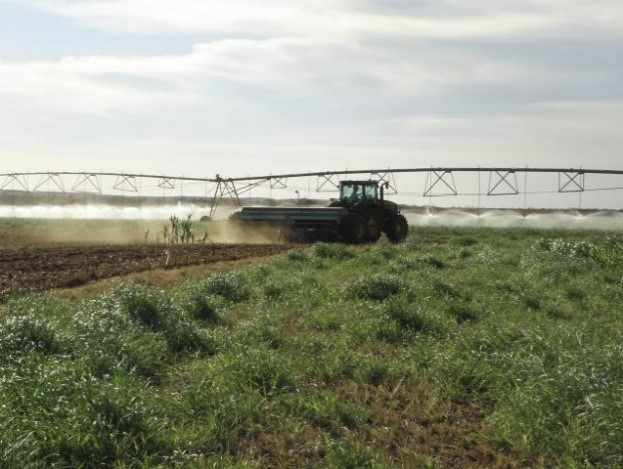
Country Areas Water Supply Act and Metropolitan Water Supply, Sewerage and Drainage Act
The Country Areas Water Supply Act 1947 (CAWS Act) and Metropolitan Water Supply, Sewerage and Drainage Act 1909 (MWSSD Act)aim to protect proclaimed catchment areas and water reserves which provide the state’s public drinking water sources and establishes a method for controlling polluted areas.
The CAWS Act and its associated regulations are used to manage and prevent the salinisation of water resources from the uncontrolled clearing of vegetation in controlled catchment areas (DWER, 2017a). These are the Mundaring Weir, Wellington Dam, Harris River Dam and Denmark River catchment areas, and the Warren River and Kent River water reserves.
The MWSSD Act makes provisions for the construction and management of the metropolitan drinking water supply, sewerage and stormwater drainage, while also establishing methods of control of water resources. The by-laws associated with both Acts are used to help protect public health and water quality of the Proclaimed Public Drinking Water Source Areas (PPDWSA) declared under the Acts (DWER, 2021).
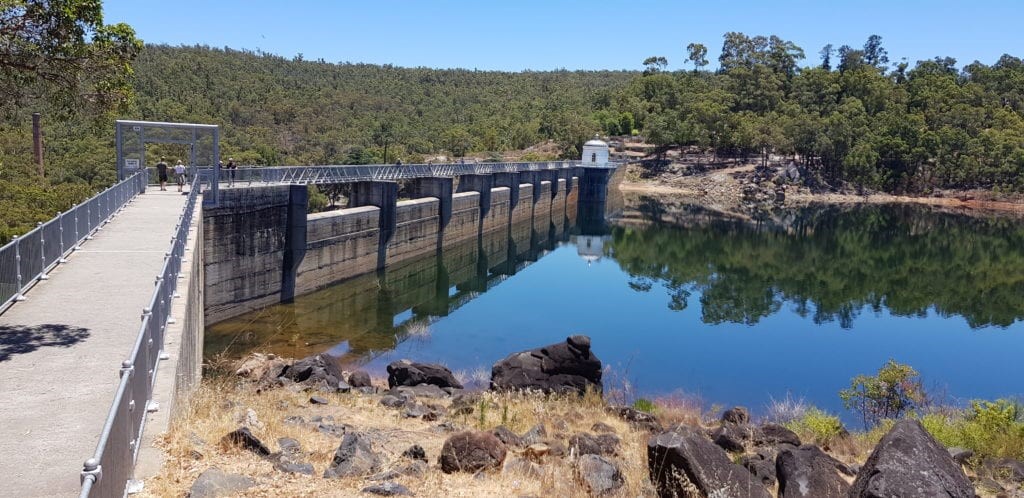
Waterways Conservation Act
Waterways are valuable assets that contribute economic, social and environmental benefits to Western Australia. Declared waterway management areas including the Albany waterways, Avon River, Wilson Inlet, Peel Inlet and Leschenault Inlet, are all managed under the Waterways Conservation Act 1976 (DWER, 2017a).
Metropolitan Arterial Drainage Act
Local governments plan, construct, operate and maintain local drainage networks, while the DWER provides the overall strategic planning and regulatory functions (Water Corporation, 2020). The Metropolitan Arterial Drainage Act 1982 provides for an arterial drainage scheme and the declaration of drainage courses which are implemented to protect properties from flooding.
Proposed Water Resources Management Act
The Western Australian government is currently working to reform legislation and policy to consolidate water resources management legislation into one Act. In August 2018, the state government approved drafting of the Water Resources Management Bill (DWER, 2017d). Water resources are currently managed under six different Acts (as mentioned above). These Acts regulate the taking and use of water, protect waterways, manage drainage and protect public drinking water sources and supply. The proposed Act aims to consolidate the six existing Acts into one modernised Water Resources Management Act.
The proposed Water Resources Management Act aims to improve the clarity of legislative provisions relating to water entitlements and management decisions, support water trade, and reduce trading and licence processing costs. It also aims to provide consistency in the regulation of metropolitan and regional areas, which currently operate under different legislations.
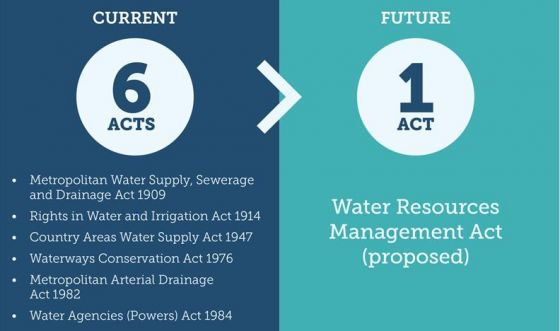
New Licence Decision Making
Currently the licensing system is ‘one size fits all’, which is sometimes inefficient. The proposed Water Resources Management Act will implement a two-tier management framework based on risk.
- Tier 1: Simplified licensing and management for water resources that have low levels of allocation and are deemed to be a low management risk; and
- Tier 2: Statutory water allocation plans and water access entitlement arrangements for high risk and fully or over-allocated water resources where competition for water is high.
Licence applications for fully-allocated water resources will no longer have to be accepted and assessed and the level of assessment will be varied according to local conditions, circumstances and risk. This removes the administrative burden of assessing applications that will ultimately be rejected. The new Water Resources Management Act aims to provide flexible management rules tailored to the level of risk to the resource. Allowing for a more flexible approach will enable simplification of the licensing process in low-risk areas and a more sophisticated way to manage high-risk areas.

New Approach to Water Use and Management
The proposed legislation will make space for innovative new ways to manage water, one example being through Managed Aquifer Recharge (MAR). MAR is the injection of recycled water into groundwater where it can be stored for later use.
The new Water Resources Management Act will establish rules for accounting for water that is stored in aquifers and by which the stored water can be abstracted. Security of ownership of stored water will be declared under the new Act, and the water options will be expanded to include examples such as stormwater/wastewater re-use (DWER, 2021).
New Ways to Manage High Use Resources
The new Water Resources Management Act will set more sophisticated management methods for high-use resources. This includes statutory allocation limits to keep water allocation within sustainable limits and varies water allocations according to seasonal availability.
The new Act will also support the establishment of statutory water allocation plans in areas where the water resource is approaching full allocation. These plans will be developed in consultation with the community (DWER, 2021).
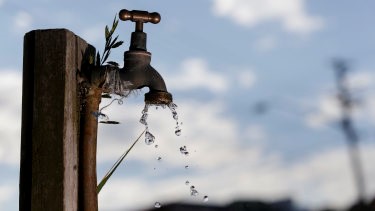
It can be challenging to ensure that your organisation complies with all the regulatory requirements relevant to their project. The team at Integrate Sustainability has a wealth of knowledge and experience with environmental regulations and compliance management. If you are unsure of your Water Licencing requirements, or if you are in need of any environmental advice or support, contact the team at Integrate Sustainability on 08 9468 0338 or email us at enquiries@integratesustainability.com.au.
References
DWER. (2017a). Water licensing in Western Australia. Retrieved from Department of Water and Environmental Regulation (DWER): https://www.water.wa.gov.au/licensing/water-licensing/types-of-licenses
DWER. (2017b). Responsibilities of Licence and Permit Holders. Retrieved from Department of Water and Environmental Regulation (DWER): https://www.water.wa.gov.au/licensing/water-licensing/responsibilities-of-licence-and-permit-holders
DWER. (2017c). Water Resources Management Legislation. Retrieved from Department of Water and Environmental Regulation (DWER): https://www.water.wa.gov.au/legislation/current-legislation/water-resources-management-legislation
DWER. (2017d). New Water Resources Management Legislation. Retrieved from Department of Water and Environmental Regulation: https://www.water.wa.gov.au/legislation/water/water-resource-management-legislation
DWER. (2021, October 25). New approach to water use. Retrieved from Department of Water and Environmental Regulations: https://www.water.wa.gov.au/legislation/water/water-resource-management-legislation/new-approach-to-water-use
DWER. (2021, October 25). New ways to manage high use resources. Retrieved from Department of Water and Environmental Regulation: https://www.water.wa.gov.au/legislation/water/water-resource-management-legislation/new-tools-to-manage-high-use-resources
DWER. (2021, October 25). Proclaiming public drinking water source areas. Retrieved from Department of Water and Environmental Regulations: https://www.water.wa.gov.au/urban-water/drinking-water/proclaiming-public-drinking-water-source-areas
Water Corporation. (2020, June 30). Drainage. Retrieved from Water Corporation: https://www.watercorporation.com.au/Developing-and-building/Land-planning/Drainage

